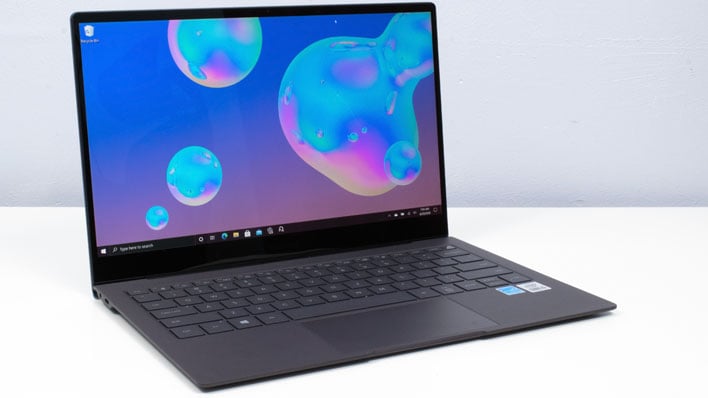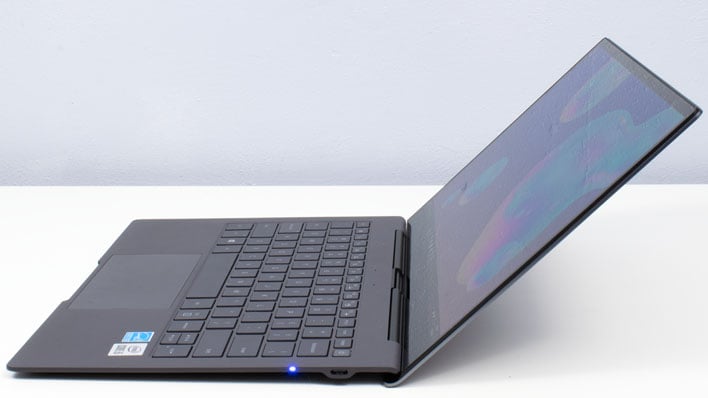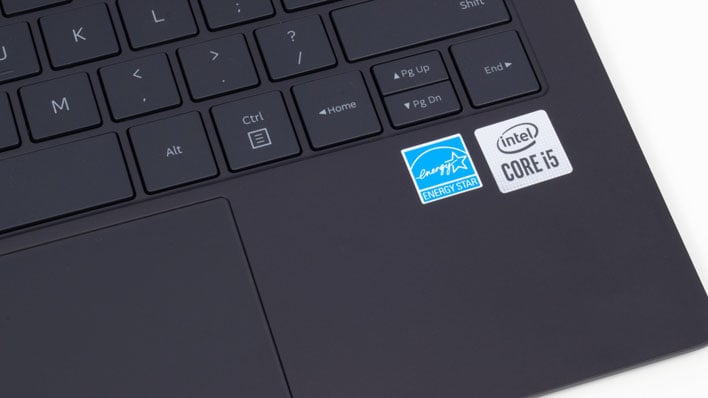Samsung Galaxy Book S Shoot-Out: Intel Lakefield Vs. Snapdragon 8cx
Samsung Galaxy Book S Wi-Fi: An Intel Lakefield Platform Showdown Vs.Qualcomm Snapdragon 8cx
Windows 10 on Arm is starting to gain more traction, thanks to a bevy of new systems based on Qualcomm's Snapdragon 8cx high-performance mobile SoC, and its second-gen follow-on which was just announced. Those laptops have all been defined by two common traits: exceptional battery life with still a few lingering app compatibility issues. Some app developers have been reticent to get on board the Arm-64 express and Microsoft is yet to enable emulation for 64-bit x86 applications, which limits overall compatibility. However, when an app does have a native Arm binary performance is solid, and the system's battery life can literally last for days. Though it's taking time, the always-on always-connected PC dream seems to be coming true.
The Snapdragon 8cx has more in common with smartphones and tablets than traditional PCs: a couple of high-clocked, high performance cores do most of the heavy lifting and a handful of slower clocked power-efficient cores handle background tasks. In Arm parlance, this is known as big.LITTLE, and recent SoCs have taken advantage of this to great effect. Qualcomm isn't the only company with its sights set on very thin notebooks with amazing endurance ratings, though. Intel has its own new take on power and efficiency with high levels of integration, code named Lakefield, along with its 3D stacked silicon technology called Foveros, which the company has been trumpeting about for over a year.
Finally, the first of those systems have peeked their heads out from the shadows and into the light, and the first one we have in the door here bears a familiar face. At the end of May, we got our first look at Samsung's new Galaxy Book S, a Snapdragon 8cx-powered laptop that delivers everything a Snapdragon-powered machine should and is probably one of the best versions of the platform on the market currently. That said, you didn't just step out of a time machine—the Galaxy Book S is back, this time with a Lakefield-based Core i5-L16G7 under the hood.
From the spec list, we can see a lot of similarities between the Core i5-L16G7-powered Galaxy Book S and its Snapdragon 8cx predecessor. In fact, the biggest difference is the SoC itself. Both systems have the same 8 GB of LPDDR4x memory soldered to the main board, clocked at 4,266 MHz, and the same soldered-down 256 GB of solid-state storage, for starters. Since we've already reviewed this laptop once, let's forget about its skins for a moment and focus on its processor platform.
The Core i5-L16G7 here is the first time we've come across a Lakefield processor in the wild. Indeed, "wild" is a good way to describe this SoC, as it marks the first time an x86 chip vendor has attempted something akin to Arm's big.LITTLE configuration. Intel uses its most current 10-nanometer process to build these chips. There's a single Sunny Cove CPU core, the same ones found in Ice Lake processors like the Core i7-1065G7 from the 2020 version of the Dell XPS 13, but with AVX 512 support disabled. For the kinds of workloads this CPU will tackle, that's not a major loss of functionality. The base clock is a mild 1.4 GHz with a maximum boost of 3 GHz. But there are more cores on board here as well of course.
After that one big core, Intel tacked on a quartet of Tremont cores, which come from its Atom line-up. That means they're low-power, energy-efficient processor cores that should be solid for background tasks and pitch in (albeit slower and with lower power consumption) in multi-threaded tasks. Once all five cores are active, the chip's maximum boost clock drops all the way down to 1.8 GHz, due in large part to the CPU's Scenario Design Power (SDP, not to be confused with Thermal Design Power, or TDP) of just 7W. All of that adds up to a total of five cores with a total of five hardware threads available. There's no Hyper-Threading here for a symmetric multi-threading boost.
Intel paired the CPU cores with a Gen 11-based Intel UHD GPU. The G7 in this chip's model name usually indicates 64 Execution Units and Iris Plus graphics, as it does with the Core i7-1065G7. In this case, the 64 EUs remain, but Intel has branded it "Intel UHD Graphics" due to the lower 500 MHz maximum clock speed, down a full 50% from the 15 W CPUs. The GPU does still support Quick Sync video encode and decode, and 4K support at 60 Hz is on tap via one of the USB-C ports running in DisplayPort Alternate Mode. We tested this out on our TCL 4K TV and it worked as expected while still powering the internal display.
This sort of hybrid processor with a low number of beefy cores and a higher count of high-efficiency cores is an area where Intel is the newcomer and Qualcomm is the established heavyweight. Can the underdog knock the champ off on its first attempt? Or will the mobile processor giant parry its way to a decision victory? There's only one way to find out -- benchmarks. In fact, we're going to do this review a little differently and present the benchmarks first, before talking about the actual real-world user experience with the systems.
We've got a pile of tests to wade through, but one of the tough issues to deal with is more limited app compatibility on the Snapdragon platform and finding common cross-platform capable benchmarks as a result. For example, Night Raid is the only 3DMark test that will run on the platform without resorting to manual settings and the CLI, and the full PCMark suite doesn't run either. So, we ran the tests we could and added some new ones. For that reason, and because this identical Samsung platform provides for a perfect shoot-out, our charts are limited to just the Galaxy Book S in chocolate and vanilla - pick your flavor.
We left both systems with their power plans set to the defaults aside from disabling sleep. This was particularly important this time around, because we tested both systems two ways: with AC power and while running on the battery. This helps to give us an idea of what performance would be like away from a wall wart. Since these are meant to be ultra mobile systems, these tests needed to be performed as if the systems were on the move. This, of course, is representative of real world user experience and use case. Without further ado, let's get to it.
Geekbench is a cross-platform benchmark that simulates real world processing workloads in image processing and particle physics scenarios. We tested the notebooks featured here in Geekbench's single and multi-core workloads. We've retired Geekbench 4 because version 5 performs many of the same tests, which have been updated with the latest CPU architectures and features in mind.

The results we see here are actually somewhat indicative of what we'll see from here on out. Intel takes the lead as the single-threaded performance leader by a fairly wide margin of 22%, thanks to that Sunny Cove core. On the other hand, Qualcomm's eight-core SoC takes the multi-threaded crown by an even wider margin of a whopping 61.2%.
The Snapdragon 8cx isn't limited to a single high-performance core—in fact, it has a quad-core Kryo 495 Gold complex to pair with its quad-core energy-efficient Kryo 495. As a result of having 60 percent mores cores, a 60% or higher advantage in a synthetic test like this isn't all that surprising. Performance on and off the charger was roughly the same on both systems with these short, bursty workloads, which is a good sign at the outset.
One of our favorite web tests is BrowserBench.org's Speedometer 2.0 test, which takes a holistic look at web application performance. This test automatically loads and runs several sample webapps from ToDoMVC.com using the most popular web development frameworks around, including React, Angular, Ember.js, and even vanilla JavaScript. This test is a better example of how systems cope with real web applications, as opposed to a pure JavaScript compute test like JetStream. All tests were performed using the latest version of Chrome.

A native version of Chrome is not available on Arm yet, so we stuck to Microsoft's new and excellent Chromium-based Edge browser for apples-to-apples comparisons, However, on the Intel platform we threw Chrome in as a bonus, which might help to serve as a bridge to other reviews, if you prefer to see that data point. Since JavaScript and most web work leans heavily on single-threaded performance, it should come as no shock that the Intel version of the Samsung Galaxy Book S runs away with this test when using identical browsers. A difference of 15% is something we think some of the more latency-sensitive users among us would feel. More surprising is just how fast Edge is: on the Core i5-L16G7 version, Microsoft's browser edged out Chrome to the tune of around 8.5%. Once again on the charger or not, performance was roughly the same on both platforms.
Next up is JetStream 2, the new and improved version of the old standby JetStream web compute benchmark. This uses a combination of JavaScript and WebAssembly to run a variety of real-world web processing scenarios from image manipulation to audio processing. At the end of the run we get a single composite score which makes it easy to compare between platforms.

Overall the Core i5-L16G7 wins this round to the tune of around 18%. Web browsing is heavily single threaded, and Sunny Cove is still unrivaled for its single-thread performance. The difference between Edge and Chrome this time is much closer, just a percentage point or so, but in the Battle of the Browsers Microsoft swept the competition. That's great news for Arm users, since that should mean that Microsoft's native browser is pretty well-optimized. Here we see the battery-powered Intel machine start to fall behind itself while attached to the wall, but it's only a couple of percentage points. The Snapdragon system was a bit more consistent overall, but it's not much of a shift and the deltas overall between the two platforms here are less significant.
Normally we would run the standard PCMark test suite, but the only version of PCMark that runs on the Arm platform is the Applications Suite. This is still a very worthwhile benchmark, as it tests the performance of Microsoft Office apps and Edge across a wide variety of scenarios. The standard PCMark suite relies on Libre Office, so it's nice that this time around that we're looking at performance of the genuine article (Microsoft Office) and the most popular suite of mainstream productivity apps on the market currently.


This pair of colorful charts tell two very interesting stories. First, the Snapdragon 8cx was just about as fast as the Intel-based machine while on AC power, with the exception of the Excel test. The other story is one of power sources over a test of about 20 minutes in length. When forced to run on the battery, the sustained productivity tests have a negative impact on the Intel machine's performance. Oddly enough, it's that same Excel test that is the least impacted, but every test score was reduced by a minimum of 15% across the board. Meanwhile the Snapdragon 8cx held strong throughout.
We'll start our 3D tests with Ye Olde Standby, 3DMark Sky Diver. This test uses the most common graphics API over the last few years, Direct X 11, to generate some 3D scenery, and also simulate physics on as many CPU cores as the processor can muster. Since these two CPUs both have four energy-efficient processor cores, this very likely comes down to how well Intel's big core can handle the Snapdragon's four high-performance cores. Officially, this test does not support Arm CPUs, but using the 3DMark command line utility, we could make it run anyway.


The biggest change on this graph is how the Intel system handled the first graphics test. Remember, this persisted across multiple runs, so something about this test causes Intel to drop around 10% of its FPS. The Core i5 can't really afford that in the first place, since the Snapdragon 8cx is already more than 25% faster than the Intel system on both tests.
Night Raid is the lightweight 3DMark DirectX 12 benchmark for casual gaming on thin and light mobile platforms. It's a perfect candidate for these two low-power processors since DirectX 12 gets us closer to the "bare metal", so to speak, so it's all about what the hardware can do.

In the overall tests, we see that the Snapdragon 8cx dominated the Core i5-L16G7. The four high-performance cores on the Snapdragon combined to thump the lonely Sunny Cove core in the CPU test to the tune of being 160% faster. Even worse for Intel, the 64 EU-wide GPU gets blasted by the Adreno 680 graphics processor. It seems like maybe the single Sunny Cove core isn't enough to drive its graphics engine to its fullest in this test, because a graphics score of 3707 is way less than half of the Core i7-1065G7's score of 9101 in the Lenovo Yoga C940. Once again, we see a return to the battery and wall power being roughly equal on both systems.

When we get to the individual graphics test scores, we can see why the Intel system lost so badly. The Intel UHD integrated GPU's frame rate trailed the Adreno 680 by 25% in both tests. Being on battery power didn't hurt the x86 CPU much, though, probably because it under-performed so badly here.
We've made some adjustments to our custom video playback loop test, and as a result these results are not directly comparable to previous tests. We changed the test away from an older build of VLC and moved to Windows Media Player. While the interface isn't all that modern, it's at least compiled for both Arm and x86, so we have a native, supported, non-beta app on both platforms. Media Player can run the same video on a repeat loops, so that's exactly what we did. The other settings remained the same: Windows 10's Focus Assist prevented notifications from popping up, we calibrated the screen brightness to around 115 lux, and a batch process kept a running log until the system finally shut down.

Well, that was unexpected. In fact, the battery life on the Intel-powered Galaxy Book S was so unexpected that we immediately recharged the battery and re-ran this test on that machine. The system achieved a very similar result the second time around (and after conditioning the battery), so we're confident in our test results. The Intel-based x86 version of the Galaxy Book S has a battery life that's less than half of what we got out of the Snapdragon 8cx system.
Intel made a lot of concessions on the performance side of the house to get power consumption down, in the hopes of boosting battery life. Not only does Intel have to settle with highly competitive performance from the Qualcomm chip here in the low-power space (winning some benchmarks, losing more than a few as well), the blue team couldn't get its Galaxy Book S battery to last anywhere nearly as long. The performance loss relative to 15 W notebooks without matching the battery life of the Snapdragon system is not a compelling combination, especially when the Arm system very nearly tied most of the time, and outright won quite handily in the critical PCMark productivity application benchmark when running on battery.
Next up we'll talk about our experience with the Lakefield powered Galaxy Book S, including how it handles video playback and some casual games, and then sum everything up in the conclusion.
The Snapdragon 8cx has more in common with smartphones and tablets than traditional PCs: a couple of high-clocked, high performance cores do most of the heavy lifting and a handful of slower clocked power-efficient cores handle background tasks. In Arm parlance, this is known as big.LITTLE, and recent SoCs have taken advantage of this to great effect. Qualcomm isn't the only company with its sights set on very thin notebooks with amazing endurance ratings, though. Intel has its own new take on power and efficiency with high levels of integration, code named Lakefield, along with its 3D stacked silicon technology called Foveros, which the company has been trumpeting about for over a year.
Finally, the first of those systems have peeked their heads out from the shadows and into the light, and the first one we have in the door here bears a familiar face. At the end of May, we got our first look at Samsung's new Galaxy Book S, a Snapdragon 8cx-powered laptop that delivers everything a Snapdragon-powered machine should and is probably one of the best versions of the platform on the market currently. That said, you didn't just step out of a time machine—the Galaxy Book S is back, this time with a Lakefield-based Core i5-L16G7 under the hood.
|
| Processor | Intel Core i5-L16G7 (5 cores x86 up to 3.0 GHz maximum turbo boost) |
| Display | 13.3-inch 1920x1080 LED backlit display with 10-point touch |
| Graphics | Intel UHD Graphics |
| Storage | 256 GB NVMe SSD (soldered) |
| Memory | 8 GB LPDDR4x (soldered) |
| Audio | Stereo Speakers |
| Camera | 720p HD Webcam |
| Networking | Intel 802.11ac Wi-Fi Bluetooth 5.0 |
| Ports: Left | 1x USB Type-C (USB 3.1 Gen 1) 1x Four-pole Headset |
| Ports: Right | 1x USB Type-C (USB 3.1 Gen 1) |
| Ports: Underneath | 1x Micro SD card reader |
| Keyboard | Chicklet-style tenkeyless keyboard with integrated fingerprint reader |
| Touchpad | Single-piece seamless touchpad with integrated buttons |
| Battery | 39.8 Watt-hour |
| Weight | 2.18 lbs (0.98 kg) |
| Dimensions | 12 x 8 x 0.24" (304.8 x 203.2 x 6.1 millimeters) |
| Warranty | 1 year limited hardware warranty |
| Operating System | Windows 10 Home |
| Price | Starts at $949.99 ($899 with promotional pricing) |
From the spec list, we can see a lot of similarities between the Core i5-L16G7-powered Galaxy Book S and its Snapdragon 8cx predecessor. In fact, the biggest difference is the SoC itself. Both systems have the same 8 GB of LPDDR4x memory soldered to the main board, clocked at 4,266 MHz, and the same soldered-down 256 GB of solid-state storage, for starters. Since we've already reviewed this laptop once, let's forget about its skins for a moment and focus on its processor platform.
The Core i5-L16G7 here is the first time we've come across a Lakefield processor in the wild. Indeed, "wild" is a good way to describe this SoC, as it marks the first time an x86 chip vendor has attempted something akin to Arm's big.LITTLE configuration. Intel uses its most current 10-nanometer process to build these chips. There's a single Sunny Cove CPU core, the same ones found in Ice Lake processors like the Core i7-1065G7 from the 2020 version of the Dell XPS 13, but with AVX 512 support disabled. For the kinds of workloads this CPU will tackle, that's not a major loss of functionality. The base clock is a mild 1.4 GHz with a maximum boost of 3 GHz. But there are more cores on board here as well of course.
After that one big core, Intel tacked on a quartet of Tremont cores, which come from its Atom line-up. That means they're low-power, energy-efficient processor cores that should be solid for background tasks and pitch in (albeit slower and with lower power consumption) in multi-threaded tasks. Once all five cores are active, the chip's maximum boost clock drops all the way down to 1.8 GHz, due in large part to the CPU's Scenario Design Power (SDP, not to be confused with Thermal Design Power, or TDP) of just 7W. All of that adds up to a total of five cores with a total of five hardware threads available. There's no Hyper-Threading here for a symmetric multi-threading boost.
Intel paired the CPU cores with a Gen 11-based Intel UHD GPU. The G7 in this chip's model name usually indicates 64 Execution Units and Iris Plus graphics, as it does with the Core i7-1065G7. In this case, the 64 EUs remain, but Intel has branded it "Intel UHD Graphics" due to the lower 500 MHz maximum clock speed, down a full 50% from the 15 W CPUs. The GPU does still support Quick Sync video encode and decode, and 4K support at 60 Hz is on tap via one of the USB-C ports running in DisplayPort Alternate Mode. We tested this out on our TCL 4K TV and it worked as expected while still powering the internal display.
Intel Lakefield And Qualcomm Snapdragon 8cx Doing Battle In The Benchmarks
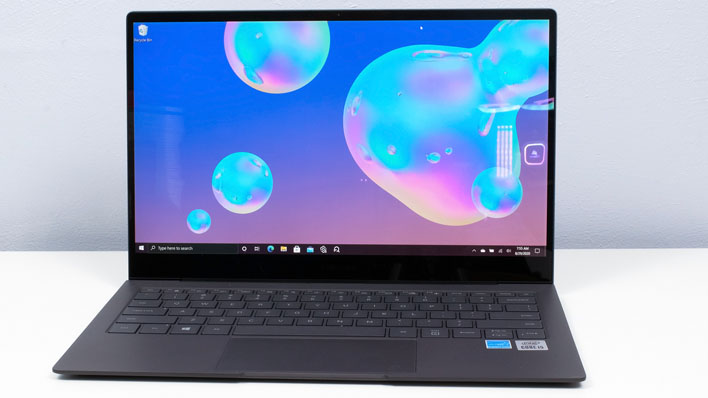
This sort of hybrid processor with a low number of beefy cores and a higher count of high-efficiency cores is an area where Intel is the newcomer and Qualcomm is the established heavyweight. Can the underdog knock the champ off on its first attempt? Or will the mobile processor giant parry its way to a decision victory? There's only one way to find out -- benchmarks. In fact, we're going to do this review a little differently and present the benchmarks first, before talking about the actual real-world user experience with the systems.
We've got a pile of tests to wade through, but one of the tough issues to deal with is more limited app compatibility on the Snapdragon platform and finding common cross-platform capable benchmarks as a result. For example, Night Raid is the only 3DMark test that will run on the platform without resorting to manual settings and the CLI, and the full PCMark suite doesn't run either. So, we ran the tests we could and added some new ones. For that reason, and because this identical Samsung platform provides for a perfect shoot-out, our charts are limited to just the Galaxy Book S in chocolate and vanilla - pick your flavor.
Snapdragon 8cx Vrs Lakefield Test Methodology
We did our best to get clean numbers by running each test a minimum of three times and reporting the median of those attempts. The only exception here is the battery test because, as the Snapdragon 8cx proves each time we run one, that it can take literally days of waiting. Otherwise, the systems were fully updated using both Samsung's update utility and Windows Update until there was nothing left to download -- these numbers are as up to date as you can get as of today.We left both systems with their power plans set to the defaults aside from disabling sleep. This was particularly important this time around, because we tested both systems two ways: with AC power and while running on the battery. This helps to give us an idea of what performance would be like away from a wall wart. Since these are meant to be ultra mobile systems, these tests needed to be performed as if the systems were on the move. This, of course, is representative of real world user experience and use case. Without further ado, let's get to it.
|
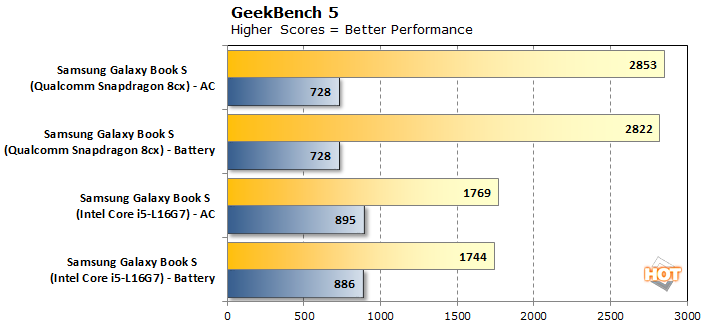
The results we see here are actually somewhat indicative of what we'll see from here on out. Intel takes the lead as the single-threaded performance leader by a fairly wide margin of 22%, thanks to that Sunny Cove core. On the other hand, Qualcomm's eight-core SoC takes the multi-threaded crown by an even wider margin of a whopping 61.2%.
The Snapdragon 8cx isn't limited to a single high-performance core—in fact, it has a quad-core Kryo 495 Gold complex to pair with its quad-core energy-efficient Kryo 495. As a result of having 60 percent mores cores, a 60% or higher advantage in a synthetic test like this isn't all that surprising. Performance on and off the charger was roughly the same on both systems with these short, bursty workloads, which is a good sign at the outset.
|

A native version of Chrome is not available on Arm yet, so we stuck to Microsoft's new and excellent Chromium-based Edge browser for apples-to-apples comparisons, However, on the Intel platform we threw Chrome in as a bonus, which might help to serve as a bridge to other reviews, if you prefer to see that data point. Since JavaScript and most web work leans heavily on single-threaded performance, it should come as no shock that the Intel version of the Samsung Galaxy Book S runs away with this test when using identical browsers. A difference of 15% is something we think some of the more latency-sensitive users among us would feel. More surprising is just how fast Edge is: on the Core i5-L16G7 version, Microsoft's browser edged out Chrome to the tune of around 8.5%. Once again on the charger or not, performance was roughly the same on both platforms.
Next up is JetStream 2, the new and improved version of the old standby JetStream web compute benchmark. This uses a combination of JavaScript and WebAssembly to run a variety of real-world web processing scenarios from image manipulation to audio processing. At the end of the run we get a single composite score which makes it easy to compare between platforms.

Overall the Core i5-L16G7 wins this round to the tune of around 18%. Web browsing is heavily single threaded, and Sunny Cove is still unrivaled for its single-thread performance. The difference between Edge and Chrome this time is much closer, just a percentage point or so, but in the Battle of the Browsers Microsoft swept the competition. That's great news for Arm users, since that should mean that Microsoft's native browser is pretty well-optimized. Here we see the battery-powered Intel machine start to fall behind itself while attached to the wall, but it's only a couple of percentage points. The Snapdragon system was a bit more consistent overall, but it's not much of a shift and the deltas overall between the two platforms here are less significant.
|
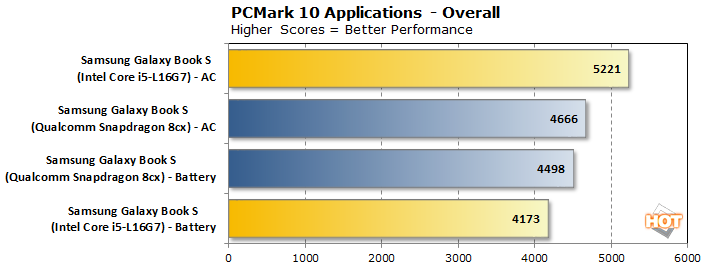
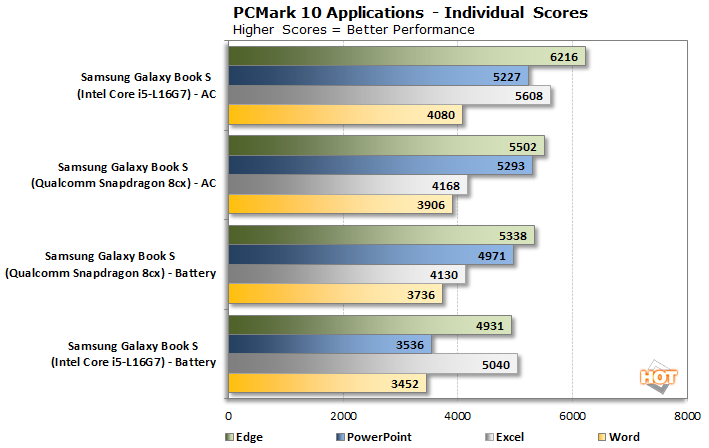
This pair of colorful charts tell two very interesting stories. First, the Snapdragon 8cx was just about as fast as the Intel-based machine while on AC power, with the exception of the Excel test. The other story is one of power sources over a test of about 20 minutes in length. When forced to run on the battery, the sustained productivity tests have a negative impact on the Intel machine's performance. Oddly enough, it's that same Excel test that is the least impacted, but every test score was reduced by a minimum of 15% across the board. Meanwhile the Snapdragon 8cx held strong throughout.
|
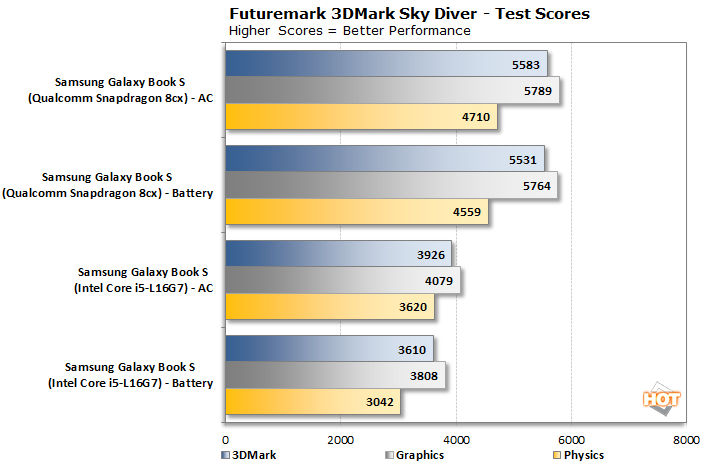
Overall, the Snapdragon 8cx aces the Core i5-L16G7 handily on both the graphics and CPU ends. When plugged into the wall, the Snapdragon mobile platform was overall around 30% faster in both the GPU-intensive graphics tests and the CPU-heavy physics benchmark. Once the power cord disconnects, that advantage is exacerbated quite a bit. The Snapdragon 8cx was 50% faster thanks to the Intel system's CPU performance falling off a cliff away from wall power. The Intel UHD integrated GPU lost some performance, but it was more like 5%.
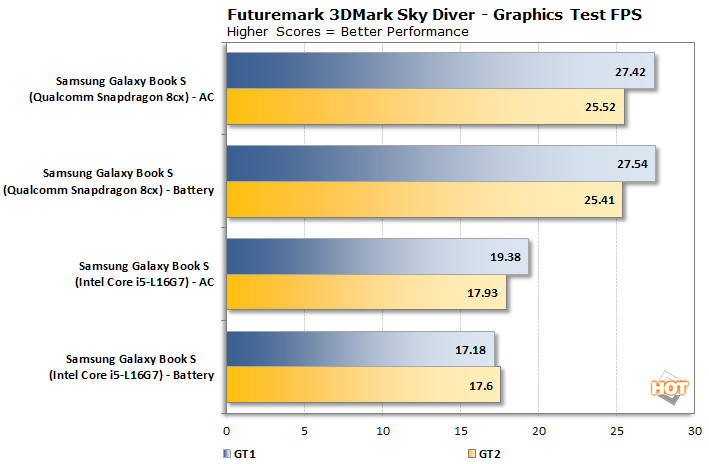
The biggest change on this graph is how the Intel system handled the first graphics test. Remember, this persisted across multiple runs, so something about this test causes Intel to drop around 10% of its FPS. The Core i5 can't really afford that in the first place, since the Snapdragon 8cx is already more than 25% faster than the Intel system on both tests.
|
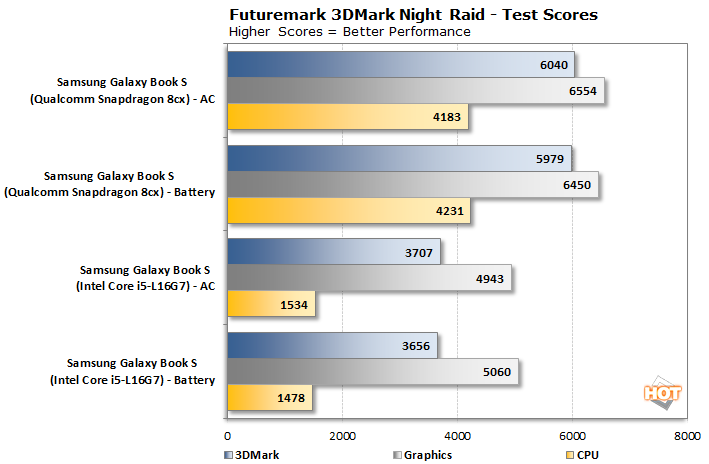
In the overall tests, we see that the Snapdragon 8cx dominated the Core i5-L16G7. The four high-performance cores on the Snapdragon combined to thump the lonely Sunny Cove core in the CPU test to the tune of being 160% faster. Even worse for Intel, the 64 EU-wide GPU gets blasted by the Adreno 680 graphics processor. It seems like maybe the single Sunny Cove core isn't enough to drive its graphics engine to its fullest in this test, because a graphics score of 3707 is way less than half of the Core i7-1065G7's score of 9101 in the Lenovo Yoga C940. Once again, we see a return to the battery and wall power being roughly equal on both systems.
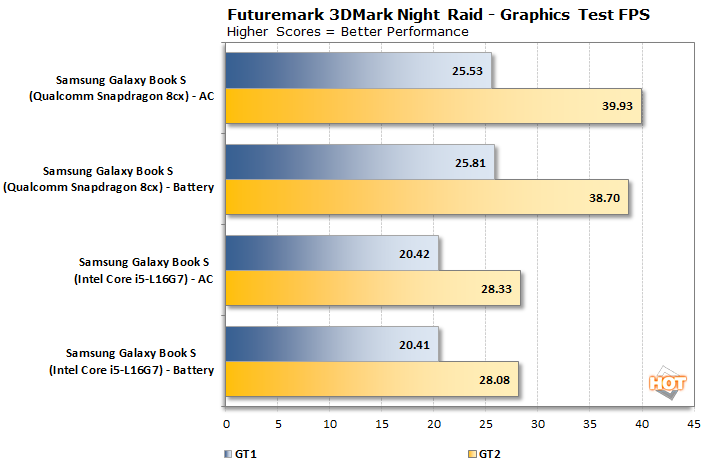
When we get to the individual graphics test scores, we can see why the Intel system lost so badly. The Intel UHD integrated GPU's frame rate trailed the Adreno 680 by 25% in both tests. Being on battery power didn't hurt the x86 CPU much, though, probably because it under-performed so badly here.
|

Well, that was unexpected. In fact, the battery life on the Intel-powered Galaxy Book S was so unexpected that we immediately recharged the battery and re-ran this test on that machine. The system achieved a very similar result the second time around (and after conditioning the battery), so we're confident in our test results. The Intel-based x86 version of the Galaxy Book S has a battery life that's less than half of what we got out of the Snapdragon 8cx system.
Intel made a lot of concessions on the performance side of the house to get power consumption down, in the hopes of boosting battery life. Not only does Intel have to settle with highly competitive performance from the Qualcomm chip here in the low-power space (winning some benchmarks, losing more than a few as well), the blue team couldn't get its Galaxy Book S battery to last anywhere nearly as long. The performance loss relative to 15 W notebooks without matching the battery life of the Snapdragon system is not a compelling combination, especially when the Arm system very nearly tied most of the time, and outright won quite handily in the critical PCMark productivity application benchmark when running on battery.
Next up we'll talk about our experience with the Lakefield powered Galaxy Book S, including how it handles video playback and some casual games, and then sum everything up in the conclusion.

